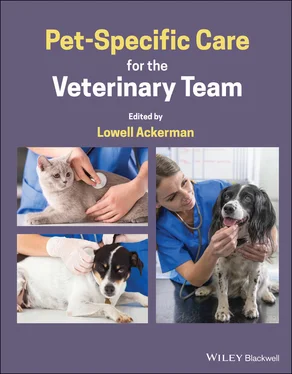Supply‐side considerations factoring into the affordability of veterinary care include the following.
Higher standards of care: the veterinary profession has responded preferentially to the higher expectations of more affluent pet owners by raising the standard of care (see 9.4Standards of Care).
Uniformity of service offerings: higher standards of care have been adopted with impressive uniformity across the profession. As a profession, veterinarians have traditionally prioritized patient needs over client needs. Veterinarians who do not keep pace risk discipline.
Professional liability issues: public attitudes toward pets and concerns over legal decisions awarding damages for emotional loss have spooked the profession. This has led to more expensive defensive medicine, justification of pricing decisions, and/or refusal to treat patients at a lower standard of care.
Practice management philosophy: veterinarians receive business counsel from a relatively small group of industry advisors. Their traditional emphasis on profitability has steered veterinarians toward a more affluent client base, often by recommending financial policies which may unintentionally discourage lower income clients.
Language and cultural barriers: the veterinary profession suffers from a lack of ethnic diversity. Fewer cross‐culturally attuned veterinarians often means fewer financial solutions for lower income pet owners.
Workplace stress and burnout: financial discussions with pet owners have been cited as one of the principal drivers of veterinary stress, leading veterinarians to avoid interactions that could potentially help pet owners overcome affordability concerns (see 8.16Dealing with Compassion Fatigue and Burnout, and 8.17 Dealing with Compromise Fatigue).
Secondary‐ and tertiary‐level care: veterinary schools and specialty centers target the most affluent of all, offering few clinical or financial options for those without the means to pay for the best services available.
Specialization: the trend toward specialization in veterinary medicine continues unabated.
Corporatization: the aggressive rate of corporatization and consolidation of veterinary practices has led to a decrease in diversity among practices in most major metropolitan areas. Standardization of clinical options and financial policies typically serves to discourage lower income clientele.
Veterinary income loss due to online pharmacy competition: the widespread adoption of online outlets for veterinary drugs and products has helped save pet owners money on these items. Unfortunately, it has also raised the price of veterinary services (see 9.10Dispensing and Prescribing).
Consolidated supplier pricing: the muscular market power of an increasingly consolidated veterinary supply industry means higher prices on veterinary drugs and supplies for pet owners, too.
The cost of veterinary higher education: higher student debt loads have translated into higher starting salaries, which are increasingly reflected in higher prices for veterinary services.
Solutions to the Pet Healthcare Affordability Crisis
Veterinarians cite financial considerations in veterinary medicine to be the principal wellspring of stress and burnout. Whether overburdened by student loan debt, bullied by suppliers or overwhelmed by clients who cannot afford to treat their unwell pets, the veterinary profession clearly has a vested interest in addressing the affordability issues that keep pet owners from caring for their pets as they would like to.
To that end, the veterinary industry has devised some strategies to help pet owners overcome their inability to pay for veterinary services, including pet health insurance (see 10.16Pet Health Insurance), payment (wellness) plans (see 10.17Payment and Wellness Plans), and third‐party financing (see 10.18Financing Veterinary Care). Other options include nonprofit and for‐profit programs for low‐income clientele, limited‐service veterinary care (e.g., vaccine clinics), publicly funded veterinary clinics, and shelter medicine programs (see 10.14Providing Cost‐Effective Care for Those in Need).
Despite these earnest attempts to address the profession's incipient affordability crisis, the veterinary profession has as yet failed to achieve a sustainable solution. Meanwhile, the divide between the “haves” and “have nots” expands exponentially with no signs of moderating any time in the near future.
The following is a list of considerations devised to mitigate costs and address other affordability concerns.
Create and standardize tiers of care based on acceptable alternatives, allowing for a variety of standards of care (see 7.8Providing Care for Those Unable or Unwilling to Pay). In this scenario, for example, a level one, minimal care standard could be considered ethical and legally defensible for financially stressed households.
Create a system by which individuals may be “income qualified” for lower cost services, thereby assessing affordability concerns more objectively. This qualification could provide a more practical, verifiable route for justification of a minimal standard of care.
Provide practical instruction for students at veterinary teaching hospitals to address affordability issues by advancing a breadth of diagnostic and treatment options. This may serve to address stigma surrounding reduced standards of care so that all practices, including secondary and tertiary care practices, can more readily offer a wider variety of care options (see 2.2The Role of Incremental Care).
Provide practice management consultation services to low‐income practices and promote the concept of for‐profit community clinics to veterinarians with shelter medicine interests or public service leanings.
Establish not‐for‐profit payment plan services to help those with low credit scores to finance care.
Negotiate more aggressively with veterinary pharmaceutical companies to provide lower cost drugs and products to prequalified low‐income pet owners or in shelter settings.
Only in very specific situations will discounting be a suitable solution (see 2.11Discounting in Veterinary Practice)
Support and promote shelter medicine and public policy programs in veterinary schools. Establish tuition reimbursement programs for students willing to practice in low‐income settings to help address these candidates' unique financial concerns.
The veterinary profession is clearly at a crossroads in its search for a meaningful, sustainable solution to this emerging crisis. The profession is undeniably well equipped with the creativity and compassion to overcome this critical issue before it affects future generations adversely, but it will need to confront it honestly and meaningfully at the highest levels of the veterinary establishment to do so. The profession is currently engaged in the early stages of exploration of this complex issue.
 TAKE‐AWAYS
TAKE‐AWAYS
Pet owners are finding it difficult to pay for the more expensive veterinary services offered by an increasingly sophisticated veterinary profession, leading to what industry analysts have described as an affordability crisis.
National economic trends toward growing income inequality and the dearth of low‐cost options for veterinary care are at odds with the increasingly widespread cultural conception of pets as family members, further inflaming affordability concerns.
Veterinarians' drive to increase standards of care, coupled with the higher cost of drugs, supplies and education, among other factors, have led to the higher priced veterinary services pet owners are increasingly unable to afford.
Читать дальше

 TAKE‐AWAYS
TAKE‐AWAYS










